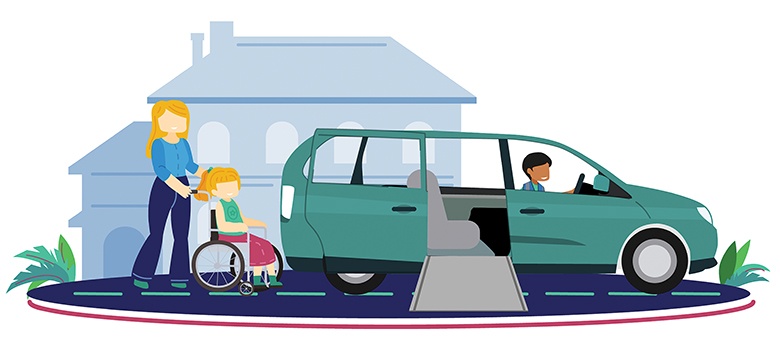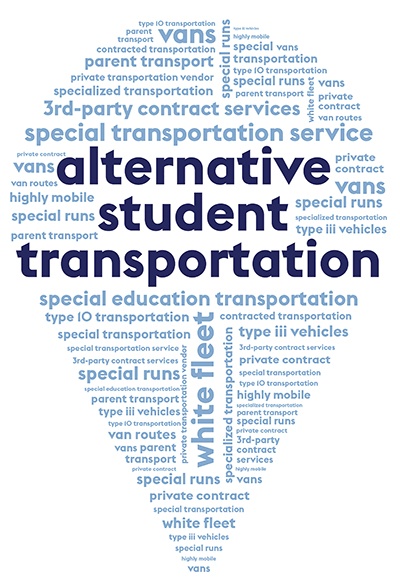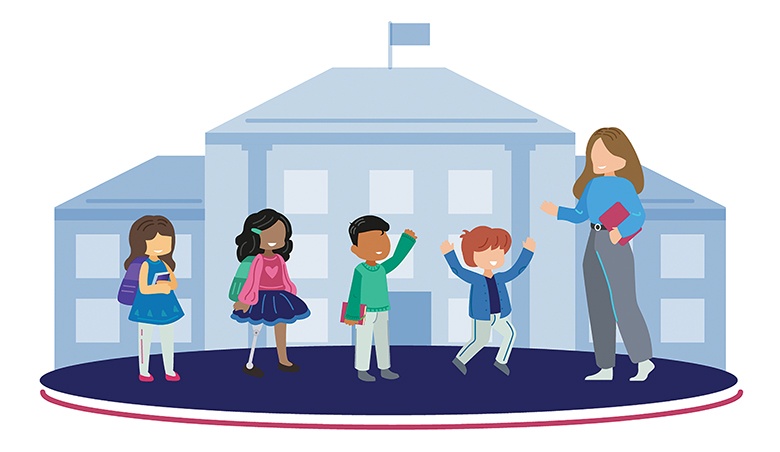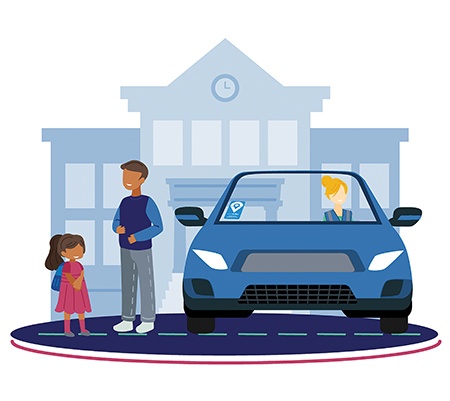
 As school districts nationwide grapple with the challenge of providing safe and reliable transportation for all of their students, many are exploring alternative strategies to optimize their resources. While the iconic yellow school bus remains the primary and traditional mode of transportation for most students, small-capacity vehicles offer a more flexible and cost-effective solution. These supplemental vehicles are often referred to as alternative student transportation.
As school districts nationwide grapple with the challenge of providing safe and reliable transportation for all of their students, many are exploring alternative strategies to optimize their resources. While the iconic yellow school bus remains the primary and traditional mode of transportation for most students, small-capacity vehicles offer a more flexible and cost-effective solution. These supplemental vehicles are often referred to as alternative student transportation.
What is alternative student transportation?
Alternative student transportation is an emerging trend, and the terminology is not yet well known or ubiquitous. You may know it as “special transportation services,” “private contracts,” “white fleet,” “highly mobile,” “special runs,” and a host of other names. Simply put, alternative student transportation refers to any mode of student transportation outside of the traditional yellow school bus. It typically includes small-capacity vehicles such as sedans, minivans, and SUVs.
The role of small-capacity vehicles in a district’s transportation program
Alternative student transportation supplements a school district’s existing program by taking on smaller routes and serving students with specific transportation needs. By utilizing smaller vehicles for these routes, school districts can:
• Maximize resources and save money by optimizing the usage of all vehicles
• Save time and improve efficiencies through enhanced routing
• Shorten ride times for students
• Offer more flexible options for families
• Accommodate students who require transportation at different times throughout the day
• Provide targeted transportation services for students with specific needs
• Facilitate equal access to education for all students
This approach allows districts to transport general education students more efficiently, while providing a safe and reliable form of transportation for all students.
Ensuring safety in small-capacity vehicles
Small-capacity vehicles are safe for students when proper precautions are met. While traditional student transportation on the bus is regulated by federal and state laws, alternative student transportation is regulated at the state level, with some states yet to codify regulations. To ensure student safety, school districts can build upon existing state regulations or, in states where regulations don’t currently exist, they can establish their own requirements. A zero-tolerance drug policy, for example, is good, but insufficient when transporting children. Districts may opt to add pre-employment, post-accident, reasonable suspicion, and random drug testing for drivers to the list of requirements.
Transparency is crucial when ensuring safety, and alternative transportation often surpasses the school bus in this aspect by providing GPS tracking, route optimization, and trip updates at the student level, along with encrypted information for drivers regarding a student’s unique needs. Furthermore, training programs for drivers of small-capacity vehicles should address the unique aspects of transporting students with diverse needs. These programs can cover topics spanning sensitivity training, communication strategies, student management techniques, and more.
In addition to driver requirements, small-capacity vehicles should meet specific safety standards. These may include regular inspections, proper maintenance, appropriate safety equipment for the student(s) being transported, and emergency procedures. Small-capacity vehicles must be required to comply, at a minimum, with the state Department of Transportation regulations regarding vehicle safety, ensuring that they are roadworthy and equipped to handle potential emergencies.
By prioritizing safety and ensuring comprehensive training, school districts can enhance the overall transportation experience for students utilizing small-capacity vehicles.
Students who benefit from small-capacity vehicle transportation
Students with special needs
Small-capacity vehicles offer customizable options to meet the specific needs of students with disabilities. Features like sensory enhancements can create a calming environment for students with autism. Individualized education plans (IEPs) may require students with certain processing disorders to ride alone, making sedans or SUVs better alternatives to a large bus. Students with mobility impairments or other medical conditions can benefit from vehicles equipped to accommodate their needs, such as wheelchair accessibility and oxygen securement. Additionally, small-capacity vehicles can provide a more inclusive and comfortable transportation experience for students with special needs, ensuring they have equitable access to education.

Students experiencing homelessness
The McKinney-Vento Homeless Assistance Act provides different kinds of assistance, including transportation, for children and youth who are experiencing homelessness. Alternative transportation provides flexible options that can be adjusted as students move from one location to another. Consistent drivers (even if a route changes because they moved over the weekend) can help create a predictable routine for these students, ensuring they have access to school despite their transient living situations. Small-capacity vehicles offer a more personalized and supportive transportation experience, fostering a sense of stability and belonging for students experiencing homelessness.
Students in foster care
Children living in foster care may face disruptions in their routines due to changes in foster placements or schools. Alternative transportation solutions can provide stability and continuity in their education by ensuring they have reliable transportation to and from school. This stability can contribute to better academic performance, as it reduces the stress and uncertainty associated with transportation issues. The flexibility and accessibility offered through small-capacity vehicles with optimized routing helps give these students a sense of empowerment and independence while providing the district with a safe and cost-effective solution for children who are often in transition.
Students attending specialty programs
Small-capacity vehicles are effective for transporting a few students attending special after-school programs or other specialized activities. These trips can be more economically and effectively served using small-capacity vehicles, allowing schools to allocate resources efficiently. For instance, students participating in adult transition programs, off-site sports practices, or academic clubs can benefit from personalized transportation arrangements that align with their program schedules.
Early childhood education students
Early childhood education programs are becoming more accessible across the country. Many districts are finding themselves needing to transport hundreds of children in car seats or boosters without buses equipped to handle them, and in some states, this safety equipment isn’t required while riding on a school bus, even for children as young as five (the typical age of a kindergartener). Using small-capacity vehicles, equipped with car seats and/or boosters, is a good option for these smaller students.
Medically fragile students
Restrictions like oxygen securement and mobility impairments can make it difficult for children who are medically fragile to get to school on a regular basis. When districts utilize small-capacity vehicles that are outfitted with the appropriate equipment to transport these students, the kiddos benefit from a more consistent education experience overall.
Students in rural areas
Transportation in rural areas often presents unique challenges due to longer distances, limited infrastructure, and fewer students to serve. Small-capacity vehicles can efficiently transport students in rural communities where larger buses may not be cost effective or practical. By employing smaller vehicles, school districts can save funds by paying only for the necessary trips. Moreover, these vehicles can navigate narrow roads and reach areas where larger buses might struggle to access, ensuring students in remote areas have safe and reliable transportation options.
Students in overcrowded urban areas
Urban areas face the opposite challenge of rural communities, with overcrowding and traffic congestion. Small-capacity vehicles offer a solution by efficiently transporting a smaller group of students, thereby reducing traffic congestion and easing the strain on the existing transportation infrastructure. These vehicles can navigate city streets more easily and provide transportation for students attending schools in high-density areas.
Extended school year and summer school
During the extended school year, enrollment numbers often decrease, resulting in smaller routes. Using alternative transportation for these routes can save money for districts without compromising on safety or reducing service quality. By utilizing small-capacity vehicles during these periods, school districts can tailor their transportation services to the specific needs of students attending extended school year programs, summer school sessions, or enrichment activities.
 Implementing small-capacity vehicles: should you manage in-house or outsource?
Implementing small-capacity vehicles: should you manage in-house or outsource?
School districts have the option of incorporating small-capacity vehicles into their fleet in-house or through outsourcing. In-house implementation involves purchasing vehicles, hiring drivers, and developing processes and procedures. This approach allows districts to have direct control over their transportation program. However, it requires substantial initial investments and ongoing expenses, including maintenance, insurance, and staffing.
Outsourcing alternative transportation can be beneficial for districts facing budget constraints, bus driver shortages, or lacking the necessary staff for driver recruiting, routing, and optimization. It offers scalable solutions, allowing districts to adjust transportation services based on demand. Contracting with external vendors specialized in alternative transportation ensures districts have access to a reliable and efficient fleet of vehicles, trained drivers, and established safety protocols. Outsourcing also offers peace of mind to parents who can track their children’s trips to and from school on an app.
When selecting an alternative transportation partner, districts should consider various factors. Safety requirements for drivers and vehicles should align with the district’s expectations and comply with state regulations and industry best practices. These include ongoing federal and state background checks, drug testing, criminal record checks, driver education, and proof of insurance. Vehicle requirements should mirror state regulations for buses, as applicable to smaller vehicles. Inspections, safety equipment, and emergency procedures should match expectations relevant to small-capacity vehicles.
Pricing for outsourced small-capacity vehicle transportation
Pricing models for alternative transportation can vary, but the majority of providers charge per trip rather than per student. However, it is crucial for districts to ensure that route optimization is also implemented to avoid paying for separate trips that could be combined.
Trips fees: When reviewing alternative bids, districts may come across several line items. The first is the trip fee, which represents the base cost of each trip and typically includes a predetermined number of miles. If the trip exceeds the included mileage, an additional fee per mile may be charged. Additionally, cancellation fees may apply, requiring a minimum number of hours to cancel a trip without incurring any costs, which typically ranges from 2 to 24 hours depending on the area.

Additional accommodations: In situations where students require additional equipment (wheelchairs, car seats, safety vests, etc.), services, or accommodation, the cost may be calculated per student. These scenarios involve advanced planning, scheduling, and routing from the transportation provider. For example, trips involving students in wheelchairs require routing, and providers that do not offer scheduling or routing may not be able to accommodate such students.
Monitors: The pricing for monitors may vary depending on whether they are provided by the district or the transportation provider. If the district provides the monitor, the ideal situation is to have the partner charge per trip with regular trip fees. However, if the provider supplies the monitor, an additional hourly fee and mileage charges might be involved for transporting the monitor after the student is dropped off.
Wait times: Wait time is another cost consideration, and the district and provider should collaborate to determine an appropriate waiting period for drivers. A fee may be charged at an hourly rate when students are late. The wait time doesn’t just affect the potential cost of the trip, however. It can also affect whether a student, or group of students, is on time for school. For solo riders, for example, a five-minute wait time may make sense, but for students sharing routes, those five-minute increments can add up quickly and cause late arrival to school while costing the district extra money in wait fees.
Contract minimums: If flexibility is a priority, districts should inquire whether potential alternative transportation providers have a contract minimum. Most providers do not, enabling districts to remain adaptable, responsive, and efficient for districts that prefer not to pay for unused trips.
Future advancements and considerations
As technology continues to advance, small-capacity vehicles are poised to benefit from innovations that further enhance safety, efficiency, and customization. Data-driven solutions can optimize routing, reduce fuel consumption, and improve student safety.
Incorporating electric vehicles into small-capacity transportation fleets can contribute to reducing carbon emissions and promoting sustainability. Electric vehicles are quieter, emit fewer pollutants, and have lower operating costs, making them an attractive option for environmentally conscious districts. As charging infrastructure improves and battery technology advances, electric small-capacity vehicles may become increasingly viable for school transportation.
Small-capacity vehicles offer a flexible and efficient transportation solution for school districts, complementing traditional bus transportation while meeting the unique needs of specific student populations. These vehicles provide safety, customization, and cost savings, ensuring that all students have equitable access to education. As districts continue to explore alternative transportation options, advancements in technology and continued research in this field will likely lead to even more innovative and impactful solutions for student transportation in the future.
Abi Studer is marketing manager for EverDriven. With a robust background in contract compliance and regulation subject matter expertise, Studer blends that experience into EverDriven’s marketing efforts. Her focus is to provide school districts across the country with actionable and relatable content to evolve their efforts with Special Needs students.


